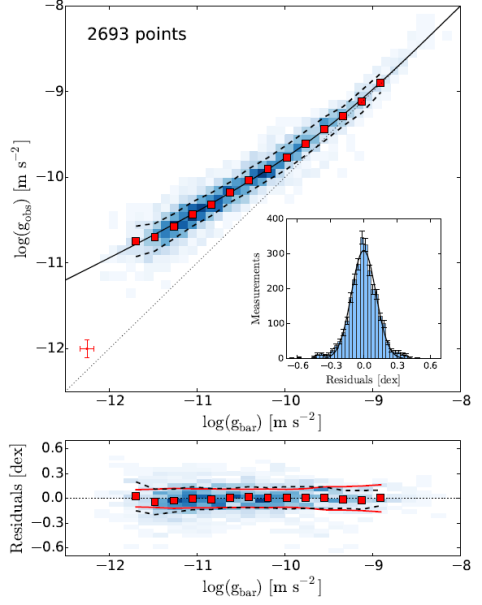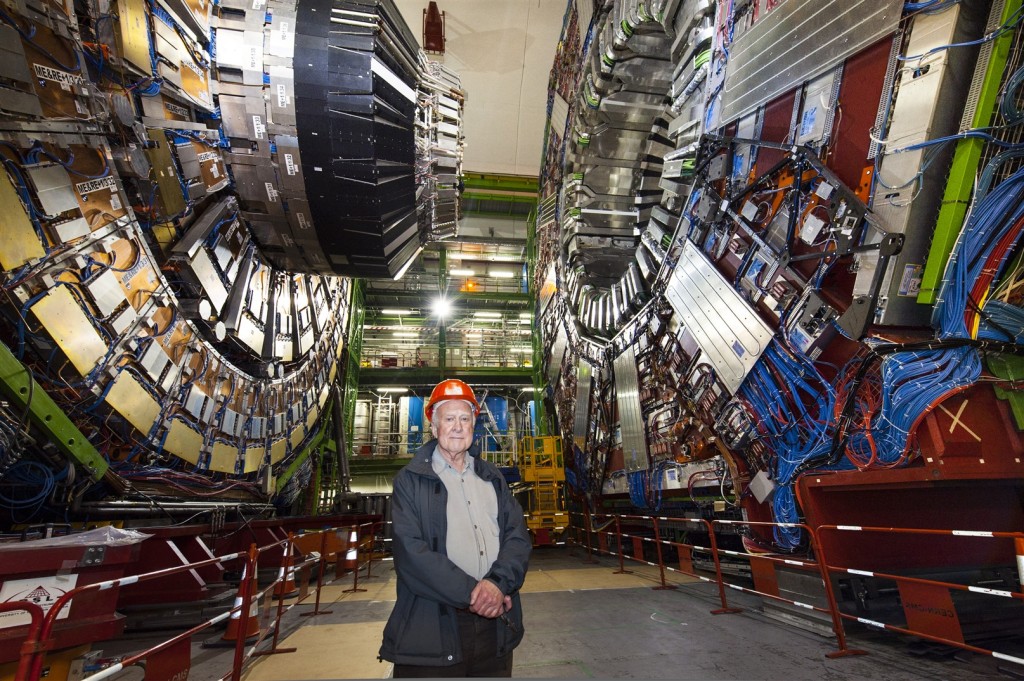A research paper1 recently accepted for publication in Physical Review Letters titled “The radial acceleration relation in rotationally supported galaxies”2 highlights a discovery that is bad news for dark matter. It certainly does not strengthen the case for halo dark matter around spiral galaxies.
The research team, McGaugh et al, took data for 153 spiral disk galaxies from the Spitzer Photometry and Accurate Rotation Curves (SPARC) database that represents spiral galaxies of all types and morphologies, from very bright to very low surface brightness disks. It included representative spiral galaxies that would be assumed to contain a very high fraction of dark matter at very low orbital accelerations to those with very little dark matter at high orbital accelerations. These galaxies are all assumed to be rotationally supported, which means their disks are assumed to be gravitationally bound by the included matter inside any radial distance (R) from the centre of the galaxy. The speeds of the stars and gases (V) as a function of their measured radial distance (R) determines what is known as a rotation curve V(R). See Fig. 1.
In this paper the observed acceleration, gobs, at each radial distance R from the centre of the chosen galaxies, was calculated from the measured values of V(R) and R for each galaxy, totalling 2693 data points over the 153 galaxies. Also using infrared data the mass density was accurately measured at these same radial points, which permitted, via the Poisson equation, a direct calculation of the expected acceleration, gbar, due to the baryonic matter (protons and neutrons, i.e. normal matter) content within the same galaxies. No free fit parameters were used in these estimations, except a single fixed Mass-to-Light ratio of 0.5 was used across all galaxies.

Assuming standard Newtonian (or Keplerian) physics the acceleration due to the baryonic matter, gbar, is all we should need to correctly calculate the rotation curve of any galaxy. See Fig. 1 (which reproduces their Fig. 2). Some representative rotation curves are shown by the upper-most black circles with error bars. Quite obviously the solid blue lines—the expect rotation velocities due to the observed baryonic matter—do not follow the observed rotation curves, but fall well below, in most galaxies. This is the reason halo dark matter is invoked. See Fig. 2.

Using only empirical data McGaugh et al find that the relationship between the acceleration expected due to baryonic matter, gbar, (from all that we can see) and the observed acceleration from measured speeds of stars and gases, gobs, is true for all galaxy types.
That relationship they find is well described by their equation 4, reproduced here:
In fact, the baryonic matter determines the observed acceleration and they discover a robust relationship with only one parameter (g†) determined from their fit, with very small errors. See Fig. 3 (which reproduces their Fig. 3).

This characteristic acceleration (g†) has a value approximately 1.2 × 10-10 m/s2 and does not depend on the galaxy type. That fact alone seriously puts the notion of dark matter in doubt and suggests that it is more likely that new physics is needed to explain the discrepancy that develops at accelerations less than g†. Note the deviation of the dotted line from the solid line in Fig. 3 for gobs below g† (10-10 m/s2).
At accelerations much greater than g† normal Keplerian motion is observed and no dark matter is needed. This, in itself, is a problem for the dark matter paradigm. Why would dark matter not gravitate to the centres of spiral galaxies when the only property that the hypothetical stuff has is that it gravitates? Yet the highest observed accelerations are not out in the disk regions, a long way from the galaxy centre, but at small radial distances from the centre of galaxies. There the McGaugh et al team found gobs = gbar, or standard Newtonian physics. But at large distances from the centres of bulge- or disk-dominated galaxies or where the accelerations are very low in small gas-dominated galaxies gobs ∝ (gbar)1/2, which is nothing like Newtonian physics predicts.
In fact at low accelerations the relationship described by Eq. (1) here becomes
gobs2 = gbar · g† (2).
This is what we would expect from new physics, which has been anticipated for a long time. It may be seen in Milgrom’s MOND (MOdified Newtonian Dynamics) and it also may be derived from Carmeli’s physics. From the latter I was able to develop such a relationship as in Eq.(2) with the only difference being g† → 2/3 a0, where a0 is a characteristic acceleration in an expanding universe. (I am not advocating either of these new physics, but pointing out that there have been attempts in this area.)
McGaugh et al write in their paper:
“…the baryons are the source of the gravitational potential.”
This means that halo dark matter is not the source of the gravitational potential in these 153 galaxies. And that means that even though we may not definitively know what the new physics suggested here is halo dark matter may now be the least viable option. The idea of a spherical halo of dark matter around a galaxy would put most of the hypothetical dark matter in regions where there is no baryonic matter and vice versa.
McGaugh et al again:
“Regardless of its theoretical basis, the radial acceleration relation exists as an empirical relation. The acceleration scale g† is in the data. The observed coupling between gobs and gbar demands a satisfactory explanation. The radial acceleration relation appears to be a law of nature, a sort of Kepler’s law for rotating galaxies.”
I would agree that new physics is needed or the initial assumption that all these galaxies are rotationally supported is wrong and because of that incorrect (and unprovable assumption) dark matter has been invoked to solve this conundrum.
References
- Stacy S. McGaugh, Federico Lelli, and James M. Schombert, Radial acceleration relation in rotationally supported galaxies, accepted in Phys. Rev. Letters, 2016.
- Stacy S. McGaugh, Federico Lelli, and James M. Schombert, Radial acceleration relation in rotationally supported galaxies, preprint, arXiv.org, 2016.






2 responses to “Why should baryons define where the dark matter is? Another dark matter problem”
Thanks for the article, John. Just a quick spell check – did you mean vice versa? 😉
LikeLike
Yes, and I have now corrected it.
LikeLiked by 1 person